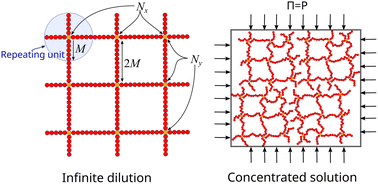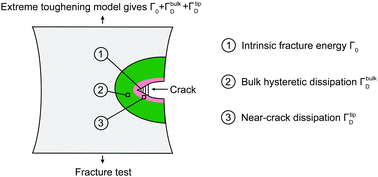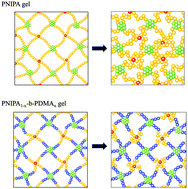Themed collection Polymer Networks

Introduction to polymer networks
Yukikazu Takeoka introduces the Soft Matter and Polymer Chemistry cross-journal themed collection on polymer networks.

Soft Matter, 2024,20, 2418-2418
https://doi.org/10.1039/D4SM90027H
Materials development in stretchable iontronics
By classifying stretchable ionic materials into three types of components (ionic conductors, ionic semiconductors, and ionic insulators), we summarized materials development in stretchable iontronics in terms of molecular interactions.

Soft Matter, 2022,18, 6487-6510
https://doi.org/10.1039/D2SM00733A
Photoinduced deformation of amorphous polyimide enabled by an improved azobenzene isomerization efficiency
A newly designed azo-PI, without pre-stretching or polarized-light irradiation, exhibits reversible bending behaviors under alternate UV and visible light irradiation, providing a facile route to deformable 2D/3D structure actuators.

Polym. Chem., 2022,13, 5447-5452
https://doi.org/10.1039/D2PY00691J
Thermoresponsive ionogels with switchable adhesion in air and aqueous environments induced by LCST phase behavior
We report a thermoresponsive ionogel with switchable adhesion both in air and aqueous environments, which can be utilized for the underwater on demand capture and release.

Soft Matter, 2022,18, 5934-5938
https://doi.org/10.1039/D2SM00542E
Reinforcement of ultrahigh thermoresistant polybenzimidazole films by hard craters
Ultrahigh thermoresistant polybenzimidazole films with uniform pores and hard craters on the surface were prepared by a silica template method. The pore and crater formation enhanced elongation and Young's modulus.

Polym. Chem., 2022,13, 4086-4089
https://doi.org/10.1039/D2PY00548D
Controlling the dynamics of elastomer networks with multivalent brush architectures
A method for lowering the activation energy of melting while improving the mechanical robustness of an elastomer was achieved using bottlebrush topologies. This system has the potential to realize self-healing materials with enhanced processability.

Soft Matter, 2022,18, 3644-3648
https://doi.org/10.1039/D2SM00328G
Single microgel degradation governed by heterogeneous nanostructures
The real-time visualization via high-speed atomic force microscopy revealed that single microgel exhibit heterogeneous degradation behavior.

Soft Matter, 2023,19, 5068-5075
https://doi.org/10.1039/D3SM00216K
Relatively homogeneous network structures of temperature-responsive gels synthesized via atom transfer radical polymerization
DLS measurements revealed that temperature-responsive gels prepared by ATRP have more homogeneous networks than those by free radical polymerization. The standard deviation of the scattered intensity is used to quantify the network inhomogeneity.

Soft Matter, 2023,19, 2505-2513
https://doi.org/10.1039/D3SM00044C
Environmentally responsive hydrogel composites for dynamic body thermoregulation
Environmentally responsive hydrogel composites embedded with submicron-sized spherical silica particles for the modulation of the mid-infrared radiation derived from the Bragg reflection are therein designed for personalized body thermoregulation.

Soft Matter, 2023,19, 2360-2369
https://doi.org/10.1039/D2SM01548J
Three-dimensional liquid crystal polymer actuators assembled by athermal photo-welding
We propose a strategy based on athermal photo-welding to construct 3D actuators assembled by azobenzene-containing linear liquid crystal polymers with different orientations, which demonstrate diverse deformations of curling, winding, and unwinding.

Soft Matter, 2023,19, 999-1007
https://doi.org/10.1039/D2SM01476A
Controlling mechanical properties of ultrahigh molecular weight ion gels by chemical structure of ionic liquids and monomers
The effect of ionic liquid and monomer structures on the mechanical properties of ultrahigh molecular weight ion gels was investigated.

Soft Matter, 2022,18, 8582-8590
https://doi.org/10.1039/D2SM00853J
Preparation of a novel regenerated silk fibroin-based hydrogel for extrusion bioprinting
A bio-printable hydrogel of regenerated silk fibroin with high-molecular-weight was prepared from its aqueous solution with the help of urea involvement, and the gelation process and properties of the hydrogel was investigated.

Soft Matter, 2022,18, 7360-7368
https://doi.org/10.1039/D2SM00984F
Temperature- and strain-dependent transient microstructure and rheological responses of endblock-associated triblock gels of different block lengths in a midblock selective solvent
Using RheoSAXS, the change in microstructure of PMMA-PnBA-PMMA triblock gels in 2-ethyl-1-hexanol subjected to oscillatory shear and temperature has been characterized.

Soft Matter, 2022,18, 7020-7034
https://doi.org/10.1039/D2SM00567K
Ionic shape memory polymer gels as multifunctional sensors
The wearable shape memory multifunctional sensor array is capable of sensing both direction and quantity of bending displacement and velocity.

Soft Matter, 2022,18, 6791-6799
https://doi.org/10.1039/D2SM00515H
Effective pH-regulated release of covalently conjugated antibiotics from antibacterial hydrogels
pH-regulated release of antibiotics is achieved by conjugation with the hydrogel matrix through the reversible imine bond.

Polym. Chem., 2022,13, 5234-5242
https://doi.org/10.1039/D2PY00505K
Molecular dynamics study of the swelling and osmotic properties of compact nanogel particles
Molecular architecture of nanogel particle.

Soft Matter, 2022,18, 6278-6290
https://doi.org/10.1039/D2SM00681B
Dually-dynamic covalent tetraPEG hydrogels end-linked with boronate ester and acylhydrazone groups
TetraPEG hydrogels cross-linked via both boronic acid ester and acylhydrazone dynamic covalent bonds were developed. Adjustment of the fraction of each type of cross-link allows the fine-tuning of hydrogel behavior between self-repair and stability.

Soft Matter, 2022,18, 5966-5978
https://doi.org/10.1039/D2SM00594H
Effect of anions on the phase transition temperature of two structurally isomeric polymers: poly(N-isopropylacrylamide) and poly(2-isopropyl-2-oxazoline)
In chaotropic solution, the different lower critical solution temperature (LCST) increments of two structural isomers, namely, poly(N-isopropylacrylamide) (PNIPAAm) and poly(2-isopropyl-2-oxazoline) (PiPOx), is studied.

Polym. Chem., 2022,13, 4615-4624
https://doi.org/10.1039/D2PY00543C
An extreme toughening mechanism for soft materials
This work utilizes a combined effort of experiment and theory to report a new mechanism and scaling law to account for extreme toughening of diverse soft materials.

Soft Matter, 2022,18, 5742-5749
https://doi.org/10.1039/D2SM00609J
Interfacial self-assembly of SiO2–PNIPAM core–shell particles with varied crosslinking density
The effect of crosslinker content and core size on the interfacial self-assembly of batch-type PNIPAM@SiO2 core–shell particles was studied, revealing parameter windows for chain phases, rhomboid packing and stable d = 448 nm non-close packed cores.

Soft Matter, 2022,18, 5585-5597
https://doi.org/10.1039/D2SM00644H
Tailoring intermolecular interactions in ion gels with rationally designed phosphonic acid polymers
Design strategies of phosphonic acid polymers established advanced ion gels with high ionic conductivity, mechanical strength, and self-healing ability via a configurable balance of ionic and hydrogen bonding interactions at the molecular level.

Polym. Chem., 2022,13, 4372-4383
https://doi.org/10.1039/D2PY00646D
Effects of cyclic and acyclic amidine side-chains on the properties of polysiloxane ionomers constructed in situ from three uncharged components
Small structural changes to side chain groups have large consequences to the structures and dynamics of corresponding polysiloxane-based ionomers.

Soft Matter, 2022,18, 5502-5508
https://doi.org/10.1039/D2SM00382A
One-pot synthesis of structure-controlled temperature-responsive polymer gels
The simultaneous use of metal Lewis acids and photo-radical generators for dithioesters, which are the common dormant species for cationic and radical polymerization, made it possible to convert a cationic species into a radical by photoirradiation.

Polym. Chem., 2022,13, 4230-4240
https://doi.org/10.1039/D2PY00554A
Shrinking rates of polymer gels composed of star-shaped polymers of N-isopropylacrylamide and dimethylacrylamide copolymers: the effect of dimethylacrylamide on the crosslinking network
The effects of monomer arrangement and composition for star-shaped polymers composed of N-isopropylacrylamide and N,N-dimethylacrylamide on the shrinkage behavior of the gels is studied, to increase their shrinkage rates without reducing the network densities of the gels.

Soft Matter, 2022,18, 5204-5217
https://doi.org/10.1039/D2SM00402J
Synergetic improvement in the mechanical properties of polyurethanes with movable crosslinking and hydrogen bonds
The synergetic effect of the movable crosslinking and the hydrogen bonds in γCDMe(x)PU contributed to the simultaneous increase in the mechanical properties such as Young’s modulus and toughness.

Soft Matter, 2022,18, 5027-5036
https://doi.org/10.1039/D2SM00408A
Time–strain inseparability in multiaxial stress relaxation of supramolecular gels formed via host–guest interactions
Time and strain effects on stress are not separable in supramolecular gels utilizing host–guest interactions in contrast to a dual cross-link gel with covalent and transient cross-links in which the separability was validated by the same assessment.

Soft Matter, 2022,18, 4953-4962
https://doi.org/10.1039/D2SM00285J
Bond strength regime dictates stress relaxation behavior
This work utilizes in situ crosslinked dynamic networks to show differences in stress-relaxation behavior depending on the bond strength of the metal–ligand crosslinker used.

Soft Matter, 2022,18, 4937-4943
https://doi.org/10.1039/D2SM00499B
Biomass-derived isosorbide-based thermoresponsive hydrogel for drug delivery
Bio-based hydrogel films are fabricated by reacting a glycerol ethoxylate-based triazide and an isosorbide-based dialkyne via Cu(I)-catalyzed photo-click reaction. These materials are suitable candidates for the delivery of therapeutic molecules.

Soft Matter, 2022,18, 4963-4972
https://doi.org/10.1039/D2SM00623E
Strength of fluid-filled soft composites across the elastofracture length
This work probes the mechanical strength of composite hydrogels as the assembly size scale of the hydrophobic secondary phase transitions across the elastofracture length.

Soft Matter, 2022,18, 4897-4904
https://doi.org/10.1039/D2SM00177B
Brownian simulations for tetra-gel-type phantom networks composed of prepolymers with bidisperse arm length
Using Brownian dynamics simulations, we studied the mechanical properties of tetra-gel-type networks with varying arm length contrast of prepolymers to modulate the number of double linkages.

Soft Matter, 2022,18, 4715-4724
https://doi.org/10.1039/D2SM00488G
Synthesis of degradable double network gels using a hydrolysable cross-linker
Biodegradable double network (DN) gels with remarkably high mechanical strength and toughness were synthesised. The biodegradable DN gels can be potentially applied in biomedical applications such as cartilage regeneration.

Polym. Chem., 2022,13, 3756-3762
https://doi.org/10.1039/D2PY00360K
Fabrication of a tunable photothermal actuator via in situ oxidative polymerization of polydopamine nanoparticles in hydrogel bilayers
In situ oxidative polymerization of polydopamine in a hydrogel matrix enables tunable photothermal actuation of a hydrogel actuator.

Soft Matter, 2022,18, 4604-4612
https://doi.org/10.1039/D2SM00420H
Linking microscopic structural changes and macroscopic mechanical responses in a near-ideal bottlebrush elastomer under uniaxial deformation
Structural changes and mechanical responses of a model bottlebrush elastomer with a controlled network structure were investigated by small-angle X-ray scattering coupled with uniaxial tensile testing.

Soft Matter, 2022,18, 4527-4535
https://doi.org/10.1039/D2SM00492E
Interpenetrated triple network polymers: synergies of three different dynamic bonds
Triply interpenetrated networks were made with a unique dynamic linker in each network. The linkers were hydrogen bonds, boronic esters and Diels–Alder adducts. Triply dynamic materials had superior properties compared to doubly dynamic analogues.

Polym. Chem., 2022,13, 3705-3712
https://doi.org/10.1039/D2PY00575A
Structure–property correlation of crosslinked domain hydrogels exhibiting thermoresponsive mechanical toughening and hybridization with photoluminescent carbon dots
A smart gel material exhibiting a simultaneous change in mechanical properties and photoluminescence is developed.

Polym. Chem., 2022,13, 3479-3488
https://doi.org/10.1039/D2PY00423B
Core–shell microgels having zwitterionic hydrogel core and temperature-responsive shell prepared via inverse miniemulsion RAFT polymerization
The temperature-responsive core–shell microgels comprising PMPC core and side-chain oligo(ethylene glycol) polymer shell were prepared via inverse miniemulsion RAFT polymerization using a water-soluble emulsifier with RAFT agent terminus.

Polym. Chem., 2022,13, 3489-3497
https://doi.org/10.1039/D2PY00425A
Linking cavitation and fracture to molecular scale structural damage of model networks
Needle-induced cavitation is performed on model end-linked gels to experimentally determine when soft solids will fail through either cavitation or fracture. Attention is also paid to when cavitation damages the network structure.

Soft Matter, 2022,18, 4220-4226
https://doi.org/10.1039/D2SM00400C
Ionic group-dependent structure of complex coacervate hydrogels formed by ABA triblock copolymers
We investigated the effect of ion pairs on the structure of complex coacervate core hydrogels (C3Gs) using small-angle X-ray/neutron scattering. The ratio between ammonium and guanidinium groups modulates both structure and salt-responsiveness of C3Gs as stimuli-responsive materials.

Soft Matter, 2022,18, 4146-4155
https://doi.org/10.1039/D2SM00255H
Mechanochromic elastomers with different thermo- and mechano-responsive radical-type mechanophores
Mechanochromic elastomers with different thermo- and mechano-responsive radical-type mechanophores are prepared and their sensitivity to heat and mechanical force is investigated.

Soft Matter, 2022,18, 3218-3225
https://doi.org/10.1039/D1SM01786A
Strain-stiffening seal
A strain-stiffening seal is soft to accommodate installation but stiff to block fluid flow. Leak by elastic deformation or rupture? We construct diagrams in which the two modes of leak are demarcated.

Soft Matter, 2022,18, 2992-3003
https://doi.org/10.1039/D2SM00068G
Visible light triggered controlled formation of rapidly self-healing hydrogels based on thiol–disulfide exchange
Biodegradable disulfide-crosslinked hydrogels were constructed via the visible light triggered thiol–disulfide exchange reaction under mild gelation conditions, and the hydrogel coatings could be rapidly self-healed in 10 min under ambient conditions.

Soft Matter, 2022,18, 3004-3012
https://doi.org/10.1039/D1SM01698A
Chiral graphene-based supramolecular hydrogels toward tumor therapy
D-Phenylalanine-based (DPFEG) hydrogel co-assembled with GO and its handedness reversal induced the selective delivery of chiral anticancer drugs under IR irradiation for tumor therapy.

Polym. Chem., 2022,13, 1685-1694
https://doi.org/10.1039/D1PY01724A
Multi-level encryption of information in morphing hydrogels with patterned fluorescence
We describe a strategy to improve information security by combining shape morphing and patterned fluorescence in a bilayer hydrogel. The information concealed in the hydrogel becomes readable after shape recovery and under UV light irradiation.

Soft Matter, 2022,18, 2149-2156
https://doi.org/10.1039/D2SM00083K
Impact of dynamic covalent chemistry and precise linker length on crystallization kinetics and morphology in ethylene vitrimers
Vitrimers, dynamic polymer networks with topology conserving exchange reactions, can lead to unusual evolution of the melting temperature and crystal structure of ethylene networks.

Soft Matter, 2022,18, 293-303
https://doi.org/10.1039/D1SM01288F
About this collection
This Polymer Chemistry and Soft Matter cross-journal collection on Polymer Networks is Guest Edited by Yukikazu Takeoka (0000-0002-1406-0704) (Nagoya University), Matsumoto Akira (0000-0002-7568-8677) (Tokyo Medical & Dental University), Akira Kakugo (0000-0002-1591-867X) (Hokkaido University), Jianping Gong (0000-0003-2228-2750) (Hokkaido University) and Alfred Crosby (0000-0001-8850-8869) (University of Massachusetts Amherst). This collection covers the physical properties, applications of, and synthetic strategies towards polymer networks, including solvent-free polymer networks, stimuli responsive polymer gels and elastomers, and polymer networks in sustainable development. The collaborative joint special issue is inspired by the fact that polymer networks truly span from the molecular chemical to the materials level.